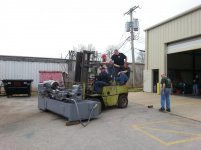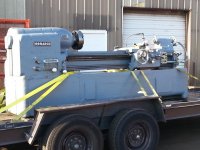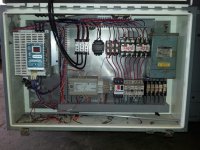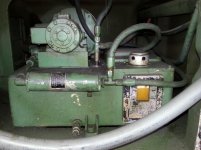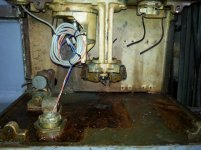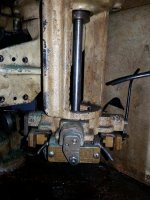Steve in SoCal
Titanium
- Joined
- Oct 17, 2006
I went and picked up the CL model 70 in Springfield, the trip was not without incident. I lost a wheel and destroyed a spindle on my trailer. Before I ever got going I had serious doubts about the forklift they used to load it.
The lathe is very heavy; my guess is well over 10K. I used my 20K forklift and it strained to lift it at the end of the forks.
They powered the lathe up and I ran it so it works sorta! The motor is a 10HP 1160RPM motor, with the spindle in open belt it will make just over 1200RPM at 88 Hz. The pulley on the motor is rather small in relation to the spindle? It has AC motors for the rapids, spindle, hydraulic pump and coolant. There is a small plc that is used to delay the spindle until it is in the high range or low range and times out the rapids motor at a preselected time. The leadscrew reverse functions and, as noted above the spindle has two ranges, low is zero speed to about 250RPM, going to a bigger motor pulley may be what is needed ? The spindle control panel is all reworked for the PLC and VFD, there is a pot to set speed, two buttons for high and low range, a button for the rapids and, a joystick for spindle rotation and start.
I have tons of questions for anyone with a 13EE-1000EE- Model 70 or 71 regarding what is here and what is missing, the spindle motor of course and the rapids motors. The rapids don't seem to be as rapid as my series 62 and that has a bicycle chain drive that could be tweaked. The constant surface dial is still on the apron but it is not connected to anything, the only guy in the shop who knew anything said it never worked while still DC. The gent who knew the machine told me the lathe was at an electric motor shop of all places when this shop got it. The former owner of this shop did the conversion, they do automation so the level of work is quite good albeit out of sync with the original speeds. The installation of motors, controls and, adapters is first rate, they perhaps just used what was laying around. The former owner was a wheeler dealer from what they tell me. The parts and pieces look like they were all scavenged from other projects?
I will post some pics in the morning, it has been a long day!!
Steve
The lathe is very heavy; my guess is well over 10K. I used my 20K forklift and it strained to lift it at the end of the forks.
They powered the lathe up and I ran it so it works sorta! The motor is a 10HP 1160RPM motor, with the spindle in open belt it will make just over 1200RPM at 88 Hz. The pulley on the motor is rather small in relation to the spindle? It has AC motors for the rapids, spindle, hydraulic pump and coolant. There is a small plc that is used to delay the spindle until it is in the high range or low range and times out the rapids motor at a preselected time. The leadscrew reverse functions and, as noted above the spindle has two ranges, low is zero speed to about 250RPM, going to a bigger motor pulley may be what is needed ? The spindle control panel is all reworked for the PLC and VFD, there is a pot to set speed, two buttons for high and low range, a button for the rapids and, a joystick for spindle rotation and start.
I have tons of questions for anyone with a 13EE-1000EE- Model 70 or 71 regarding what is here and what is missing, the spindle motor of course and the rapids motors. The rapids don't seem to be as rapid as my series 62 and that has a bicycle chain drive that could be tweaked. The constant surface dial is still on the apron but it is not connected to anything, the only guy in the shop who knew anything said it never worked while still DC. The gent who knew the machine told me the lathe was at an electric motor shop of all places when this shop got it. The former owner of this shop did the conversion, they do automation so the level of work is quite good albeit out of sync with the original speeds. The installation of motors, controls and, adapters is first rate, they perhaps just used what was laying around. The former owner was a wheeler dealer from what they tell me. The parts and pieces look like they were all scavenged from other projects?
I will post some pics in the morning, it has been a long day!!
Steve



 It is nice when you have good electrical work and not hacked up junk. I'm wondering if they had an "as built" electrical drawing to go with it? That would save a lot of time...
It is nice when you have good electrical work and not hacked up junk. I'm wondering if they had an "as built" electrical drawing to go with it? That would save a lot of time...